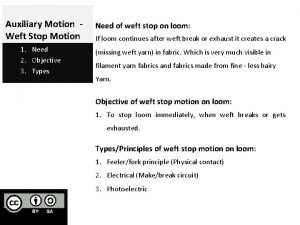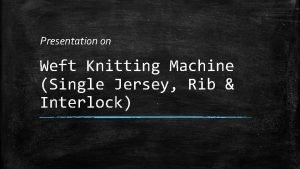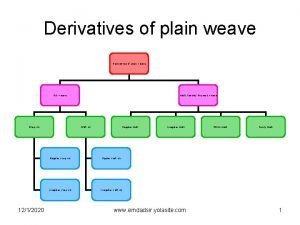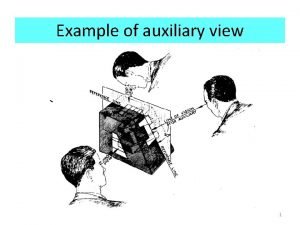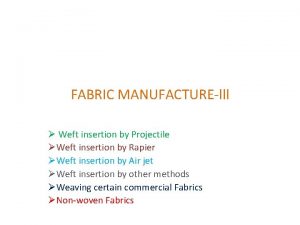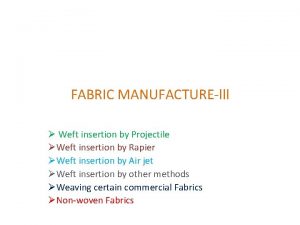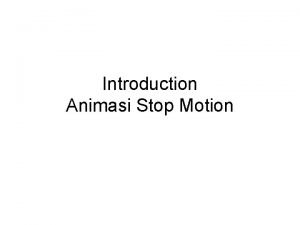Auxiliary Motion Weft Stop Motion 1 Need 2





- Slides: 5

Auxiliary Motion Weft Stop Motion 1. Need 2. Objective 3. Types Need of weft stop on loom: If loom continues after weft break or exhaust it creates a crack (missing weft yarn) in fabric. Which is very much visible in filament yarn fabrics and fabrics made from fine - less hairy Yarn. Objective of weft stop motion on loom: 1. To stop loom immediately, when weft breaks or gets exhausted. Types/Principles of weft stop motion on loom: 1. Feeler/fork principle (Physical contact) 2. Electrical (Make/break circuit) 3. Photoelectric

Auxiliary Motion Weft stop motion Weft Stop Motion 1. Classification Side weft fork motion Advantage: 1. Simple and robust Mechanism fitted at one side of loom. Disadvantage: 1. It works once for every 2 picks, which may results in crack/broken pick in fabric and in case of drop box missing pick of particular box or broken pick occurs. Not suitable for pick at will type drop box. 2. It works even weft tension is less, may cause weft loop. 3. Prongs might damage weft if not maintained properly. Centre weft fork motion Advantage: 1. Complicated Mechanism fitted at centre of loom. 2. Works on every pick. 3. Less chances of broken picks. 4. Suitable for all types of material and loom. 5. Suitable for pick at will type drop box.

Auxiliary Motion Weft stop Motion Side weft fork stop Mechanism : 1. Side weft fork stop motion Weft Missing Fork Knock off lever Weft Fork support Weft Hammer Greyhound tail lever Starting handle Normal Working Bottom shaft Cam Weft Missing

Auxiliary Motion Weft stop Motion 1. Requirements of Side weft fork stop Mechanism : v Have a grid set into the back of sley and adjacent to reed as well opposite to the fork. v Race board should have a groove so that the fork’s prongs can operate below race board level and makes difficult for weft to pass below it. Reed Grid Fork Reed Race board Groove

Auxiliary Motion Weft stop Motion Centre weft fork Mechanism : 1. Diagram Guide. Collars Driving fixed to sley Collar Knock off notch Bowl Knock off rod Return spring Collar Weft Knock off lever Driving rod fork Weft fork support cam bracket Weft feeler Sley drives driving rod
